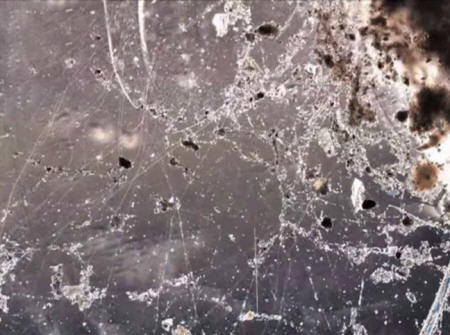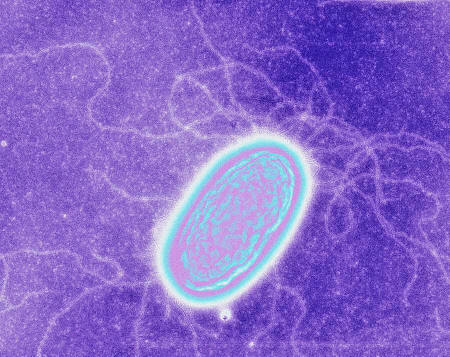|
Some intrepid biologists at the University of Southern California (USC) have discovered bacteria that survives on nothing but electricity - rather than food, they eat and excrete pure electrons.
These bacteria yet again prove the almost miraculous tenacity of life - but, from a technology standpoint, they might also prove to be useful in enabling the creation of self-powered nanoscale devices that clean up pollution.
Some of these bacteria also have the curious ability to form into 'biocables,' microbial nanowires that are centimeters long and conduct electricity as well as copper wires - a capability that might one day be tapped to build long, self-assembling subsurface networks for human use.
As you may recall from high school biology, almost every living organism consumes sugar to survive.
When it gets right down to it, everything you eat is ultimately converted or digested into single molecules of glucose. Without going into the complexities of respiration and metabolism (ATP!), these sugars have excess electrons - and the oxygen you breathe in really wants those electrons.
By ferrying electrons from sugar to oxygen, a flow of electrons - i.e. energy - is created, which is then used to carry out various vital tasks around your body (triggering electrons, beating your heart, etc.)
These special bacteria, however, don't need no-poxy sugars - instead, they cut out the middleman and feed directly on electrons.
To discover these bacteria, and to cultivate them in the lab, the USC biologists quite simply scooped up some sediment from the ocean, took it back to the lab, stuck some electrodes into it, and then turned on the power.
When higher voltages are pumped into the water, the bacteria "eats" electrons from the electrode; when a lower voltage is present, the bacteria "exhales" electrons onto the electrode, creating an electrical current (which could be used to power a device, if you were so inclined).
The USC study very carefully controlled for other sources of nutrition - these bacteria were definitely eating electrons directly.
A beautiful photo of a geobacter metallireducens bacterium, taken by Derek Lovley
All told, various researchers around the world have now discovered upwards of 10 different kinds of bacteria that feed on electricity - and, interestingly, they're all pretty different (they're not from the same family), and none of them are like Shewanella or Geobacter, two well-known bacteria that have interesting electrical properties.
Kenneth Nealson of USC, speaking to New Scientist about his team's discovery, said:
As for the repercussions of finding bacteria that eat and excrete electrons, the most obvious use is in the growing fields of molecular motors and nanomachines.
These bacteria, at their most basic, are machines that consume raw electricity - and so, with some clever (genetic?) engineering, it stands to reason that we might one day use them to power tiny machines that can perform tasks that are currently carried out by expensive, human-operated machines (cleaning up chemical spills, for example).
These bacteria might also allow us to find out exactly how much energy a living cell needs to survive; put them in a test tube, and then slowly dial back the electrode voltage until they die. A cruel experiment, but one that would yield very informative results.
In a separate study a few years ago, researchers at Aarhus University in Denmark found that some electric bacteria also have the ability to form microbial nanowires - long chains of bacteria that can span several centimeters.
These nanowires ferry nutrients to bacteria further down the chain, which might be stuck underneath some mud. Curiously, these nanowires are about as conductive as standard copper wires, which leads us to wonder if electric bacteria might one day be coerced into building subsurface networks for human use.
It would be a little more efficient than spending billions of dollars on laying submarine cables…
Live on Pure Energy
from
NewScientist Website
STICK an electrode in the ground, pump electrons down it, and they will come: living cells that eat electricity.
We have known bacteria to survive on a variety of energy sources, but none as weird as this. Think of Frankenstein's monster, brought to life by galvanic energy, except these "electric bacteria" are very real and are popping up all over the place.
Unlike any other living thing on Earth, electric bacteria use energy in its purest form - naked electricity in the shape of electrons harvested from rocks and metals. We already knew about two types, Shewanella and Geobacter.
Now, biologists are showing that they can entice many more out of rocks and marine mud by tempting them with a bit of electrical juice. Experiments growing bacteria on battery electrodes demonstrate that these novel, mind-boggling forms of life are essentially eating and excreting electricity.
That should not come as a complete surprise, says Kenneth Nealson at the University of Southern California, Los Angeles.
We know that life, when you boil it right down, is a flow of electrons:
Our cells break down the sugars, and the electrons flow through them in a complex set of chemical reactions until they are passed on to electron-hungry oxygen.
In the process, cells make ATP, a molecule that acts as an energy storage unit for almost all living things. Moving electrons around is a key part of making ATP.
In most living things, the body packages the electrons up into molecules that can safely carry them through the cells until they are dumped on to oxygen.
The discovery of electric bacteria shows that some very basic forms of life can do away with sugary middlemen and handle the energy in its purest form - electrons, harvested from the surface of minerals.
Nealson's team is one of a handful that is now growing these bacteria directly on electrodes, keeping them alive with electricity and nothing else - neither sugars nor any other kind of nutrient.
The highly dangerous equivalent in humans, he says, would be for us to power up by shoving our fingers in a DC electrical socket. To grow these bacteria, the team collects sediment from the seabed, brings it back to the lab, and inserts electrodes into it.
First they measure the natural voltage across the sediment, before applying a slightly different one.
A slightly higher voltage offers an excess of electrons; a slightly lower voltage means the electrode will readily accept electrons from anything willing to pass them off. Bugs in the sediments can either "eat" electrons from the higher voltage, or "breathe" electrons on to the lower-voltage electrode, generating a current.
That current is picked up by the researchers as a signal of the type of life they have captured.
Electric bacteria connect to form wires Unlike any other life on Earth, these extraordinary bacteria use energy in its purest form - they eat and breathe electrons - and they are everywhere
Shocking breath
At the Goldschmidt geoscience conference in Sacramento, California, last month, Shiue-lin Li of Nealson's lab presented results of experiments growing electricity breathers in sediment collected from Santa Catalina harbour in California.
Yamini Jangir, also from the University of Southern California, presented separate experiments which grew electricity breathers collected from a well in Death Valley in the Mojave Desert in California.
Over at the University of Minnesota in St Paul, Daniel Bond and his colleagues have published experiments showing that they could grow a type of bacteria that harvested electrons from an iron electrode (Cultivation of an Obligate Fe(II)-Oxidizing Lithoautotrophic Bacterium Using Electrodes).
That research, says Jangir's supervisor Moh El-Naggar, may be the most convincing example we have so far of electricity eaters grown on a supply of electrons with no added food.
But Nealson says there is much more to come. His PhD student Annette Rowe has identified up to eight different kinds of bacteria that consume electricity. Those results are being submitted for publication.
Nealson is particularly excited that Rowe has found so many types of electric bacteria, all very different to one another, and none of them anything like Shewanella or Geobacter.
Discovering this hidden biosphere is precisely why Jangir and El-Naggar want to cultivate electric bacteria.
The researchers plan to install a battery inside a gold mine in South Dakota to see what they can find living down there.
NASA is also interested in things that live deep underground because such organisms often survive on very little energy and they may suggest modes of life in other parts of the solar system.
Electric bacteria could have practical uses here on Earth, however, such as creating biomachines that do useful things like clean up sewage or contaminated groundwater while drawing their own power from their surroundings. Nealson calls them self-powered useful devices, or SPUDs.
Practicality aside, another exciting prospect is to use electric bacteria to probe fundamental questions about life, such as what is the bare minimum of energy needed to maintain life.
For that we need the next stage of experiments, says Yuri Gorby, a microbiologist at the Rensselaer Polytechnic Institute in Troy, New York: bacteria should be grown not on a single electrode but between two.
These bacteria would effectively eat electrons from one electrode, use them as a source of energy, and discard them on to the other electrode.
Gorby believes bacterial cells that both eat and breathe electrons will soon be discovered.
It may also be possible to vary the voltage applied to the electrodes, putting the energetic squeeze on cells to the point at which they are just doing the absolute minimum to stay alive.
In this state, the cells may not be able to reproduce or grow, but they would still be able to run repairs on cell machinery.
How much juice do you need to keep a living electric bacterium going?
Answer that question, and you've answered one of the most fundamental existential questions there is.
Wire in the mud
Electric bacteria come in all shapes and sizes.
A few years ago, biologists discovered that some produce hair-like filaments that act as wires, ferrying electrons back and forth between the cells and their wider environment.
They dubbed them microbial nanowires.
Lars Peter Nielsen and his colleagues at Aarhus University in Denmark have found that tens of thousands of electric bacteria can join together to form daisy chains that carry electrons over several centimeters - a huge distance for a bacterium only 3 or 4 micrometers long. It means that bacteria living in, say, seabed mud where no oxygen penetrates, can access oxygen dissolved in the seawater simply by holding hands with their friends.
Such bacteria are showing up everywhere we look, says Nielsen.
One way to find out if you're in the presence of these electron munchers is to put clumps of dirt in a shallow dish full of water, and gently swirl it. The dirt should fall apart. If it doesn't, it's likely that cables made of bacteria are holding it together.
Nielsen can spot the glimmer of the cables when he pulls soil apart and holds it up to sunlight (see video).
Flexible biocables
It's more than just a bit of fun. Early work shows that such cables conduct electricity about as well as the wires that connect your toaster to the mains. That could open up interesting research avenues involving flexible, lab-grown biocables.
|


